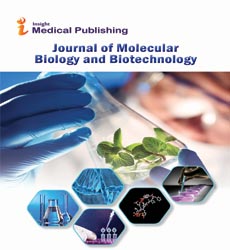An Overview on Genetically Modified Plant
Benjamin Crysup*
Department of Molecular Biology, Bahir Dar University, Bahir Dar, Ethiopia
- *Corresponding Author:
- Benjamin Crysup
Department of Molecular Biology,
Bahir Dar University,
Bahir Dar,
Ethiopia,
Email: benjamin@st-crysup.ac.ei
Received Date: November 17, 2021; Accepted Date: November 30, 2021; Published Date: December 07, 2021
Citation: Crysup B (2021) An Overview on Genetically Modified Plant. J Mol Biol Biotech Vol.6 No.S1:002.
Description
Hereditarily changed plants have been designed for logical exploration, to make new shadings in plants, convey antibodies, and to make upgraded crops. Plant genomes can be designed by actual techniques or by utilization of Agrobacterium for the conveyance of successions facilitated in T-DNA twofold vectors. Many plant cells are pluripotent, implying that a solitary cell from an experienced plant can be collected and afterward under the right conditions structure another plant. This limit can be taken advantage of by innate trained professionals; by choosing for cells that have been effectively changed in a grown-up plant another plant would then be able to be developed that contains the transgene in each cell through an interaction known as tissue culture.
A significant part of the advances in the field hereditary designing has come from experimentation with tobacco. Significant advances in tissue culture and plant cell instruments for a wide scope of plants has begun from frameworks created in tobacco. It was the primary plant to be hereditarily designed and is viewed as a model creature for hereditary designing, however a scope of other fields. As such the transgenic devices and systems are grounded making it probably the least demanding plant to transform. Another significant model living being applicable to hereditary designing is Arabidopsis thaliana. Its little genome and short life cycle makes it simple to control and it contains numerous homologs to significant harvest species. It was the main plant sequenced, has bountiful Bioinformatic assets and can be changed by basically dunking a blossom in a changed Agrobacterium solution.
Research
In research, plants are designed to assist with finding the elements of specific qualities. The most straightforward method for doing this is to eliminate the quality and see what aggregate creates contrasted with the wild sort structure. Any distinctions are potentially the consequence of the missing quality. Dissimilar to mutagenesis, hereditary designing permits designated expulsion without disturbing different qualities in the organism. Some qualities are just communicated in specific tissue, so columnist qualities, similar to GUS, can be connected to the quality of interest permitting perception of the location. Other ways of testing a quality is to adjust it somewhat and afterward return it to the plant and check whether it actually has a similar impact on aggregate. Different techniques incorporate connecting the quality to a solid advertiser and see what happens when it is over communicated, driving a quality to be communicated in an alternate area or at various formative stages.
Ornamental
Some hereditarily changed plants are simply fancy. They are adjusted for lower tone, aroma, and blossom shape and plant architecture. The primary hereditarily changed ornamentals marketed adjusted color. Carnations were conveyed in 1997, with the most popular innately changed natural substance, a blue rose (really lavender or mauve) made in 2004. Other hereditarily adjusted ornamentals incorporate Chrysanthemum and Petunia. As well as expanding tasteful worth there are plans to foster ornamentals that utilization less water or are impervious to the cool, which would permit them to be become outside their indigenous habitats.
Conservational
It has been proposed to hereditarily alter some plant species undermined by termination to be safe obtrusive plants and sicknesses, for example, the emerald debris drill in North American and the contagious illness, Ceratocystis platani, in European plane trees. The papaya ring spot infection (PRSV) crushed papaya trees in Hawaii in the 20th century until transgenic papaya plants were given microorganism determined resistance. However, hereditary alteration for protection in plants remains mostly speculative. An interesting concern is that a transgenic animal groups may presently don't look similar to the first species to genuinely guarantee that the first species is being moderated. All things being equal, the transgenic species might be hereditarily unique enough to be viewed as another species, along these lines reducing the protection worth of hereditary adjustment.
Vaccines
Antibody creation and capacity has incredible potential in transgenic plants. Immunizations are costly to deliver; ship and control, so having a framework that could create them locally would permit more prominent admittance to more unfortunate and creating areas. As well as cleaning antibodies communicated in plants it is additionally conceivable to create palatable antibodies in plants. Palatable antibodies invigorate the safe framework when ingested to secure against specific infections. Being put away in plants decreases the drawn out cost as they can be scattered without the requirement for cold stockpiling, don't should be decontaminated and have long haul soundness. Additionally being housed inside plant cells gives some insurance from the stomach acids upon assimilation. Anyway the expense of creating, directing and containing transgenic plants is high, prompting most current plant-based antibody improvement being applied to veterinary medication, where the controls are not as severe.
Open Access Journals
- Aquaculture & Veterinary Science
- Chemistry & Chemical Sciences
- Clinical Sciences
- Engineering
- General Science
- Genetics & Molecular Biology
- Health Care & Nursing
- Immunology & Microbiology
- Materials Science
- Mathematics & Physics
- Medical Sciences
- Neurology & Psychiatry
- Oncology & Cancer Science
- Pharmaceutical Sciences
